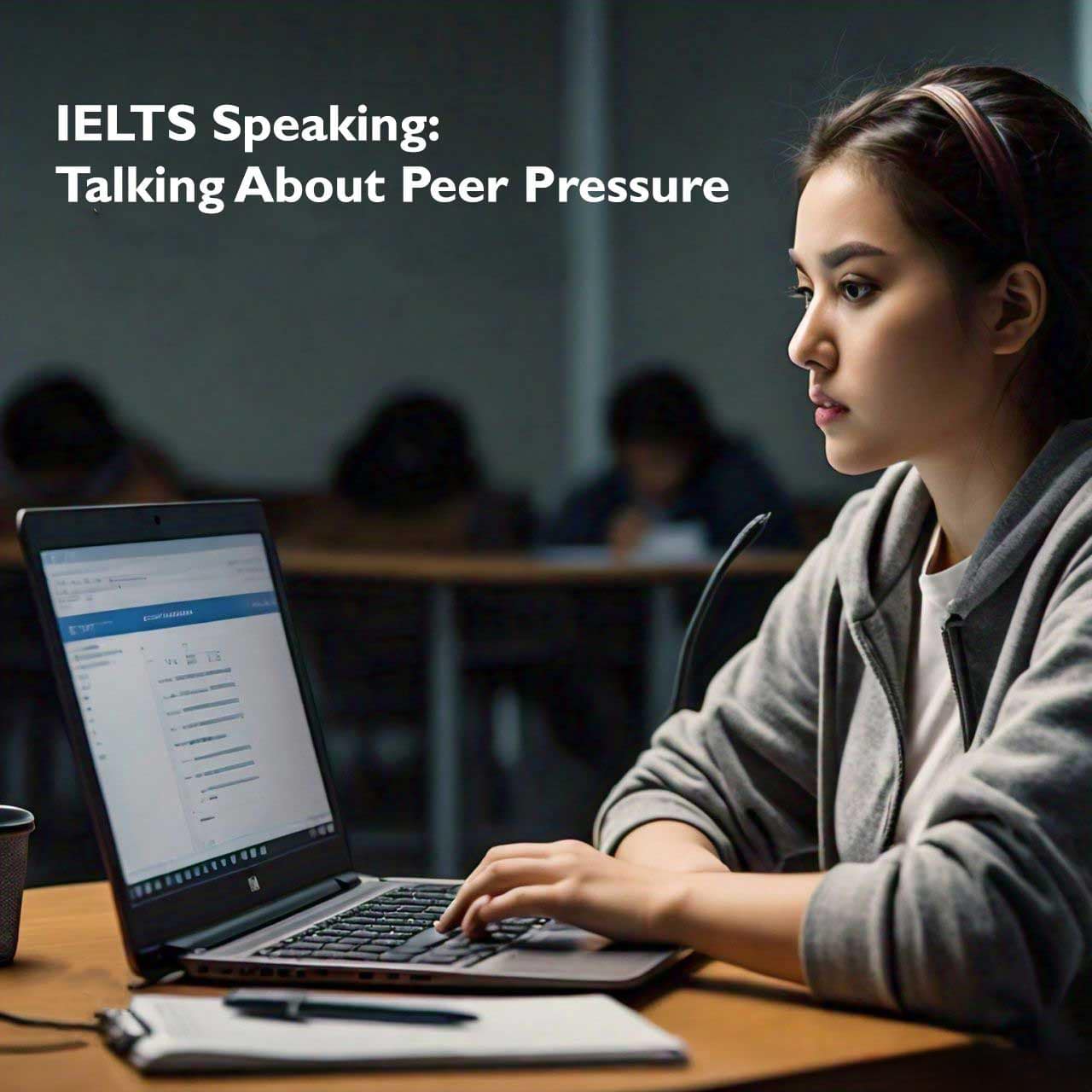The IELTS Speaking test is designed to evaluate your ability to communicate effectively in English on a variety of topics. One common topic that may arise during the test is peer pressure. Peer pressure is a prevalent issue, especially among teenagers and young adults, and it can affect people in various ways. Being able to discuss this topic confidently and thoughtfully can help you score higher in the Speaking test. In this blog post, we’ll explore how to talk about peer pressure in the IELTS Speaking test, providing useful vocabulary, phrases, and strategies to help you articulate your thoughts clearly and coherently.
Table of Contents
Understanding the IELTS Speaking Test
The IELTS Speaking test is divided into three parts:
1. Part 1: Introduction and Interview – You’ll answer questions about yourself and familiar topics such as your home, family, work, studies, and interests.
2. Part 2: Long Turn – You’ll be given a topic and have one minute to prepare a two-minute talk. Afterward, the examiner may ask you one or two questions related to your talk.
3. Part 3: Discussion – The examiner will ask you further questions related to the topic in Part 2, which allows for a deeper discussion.
The ability to discuss topics like peer pressure effectively in these parts can demonstrate your fluency, coherence, and ability to express complex ideas.
Key Points to Consider When Discussing Peer Pressure
1. Define Peer Pressure
Start by defining what peer pressure is. This helps set the stage for your discussion and shows the examiner that you understand the topic.
– Definition: Peer pressure is the influence exerted by a peer group on its members to conform to the group’s expectations and behaviors. It can be positive or negative and is particularly common during adolescence and young adulthood.
2. Types of Peer Pressure
Discuss the different forms of peer pressure, providing examples to illustrate each type.
– Direct Peer Pressure: When someone explicitly tells you what you should or shouldn’t do. For example, friends urging you to skip school to hang out.
– Indirect Peer Pressure: More subtle, where the influence comes from observing others’ behaviors. For example, feeling compelled to dress a certain way because it’s the trend among your friends.
– Positive Peer Pressure: When the influence encourages beneficial behaviors. For example, friends encouraging you to study hard and achieve good grades.
– Negative Peer Pressure: When the influence pushes you towards harmful behaviors. For example, being pressured into trying alcohol or drugs.
3. Effects of Peer Pressure
Discuss how peer pressure can affect individuals, both positively and negatively. Use specific examples to illustrate your points.
– Positive Effects:
– Encouragement to Succeed: Positive peer pressure can motivate individuals to achieve their goals, such as improving grades or joining extracurricular activities.
– Support in Healthy Habits: Friends can encourage each other to adopt healthier lifestyles, like exercising or eating well.
– Negative Effects:
– Engaging in Risky Behaviors: Peer pressure can lead individuals to partake in risky activities, such as substance abuse or illegal activities.
– Mental Health Issues: The pressure to conform can cause stress, anxiety, and low self-esteem.
4. Personal Experiences
Talking about your own experiences with peer pressure can make your discussion more engaging and authentic. Reflect on times when you faced peer pressure and how you dealt with it.
– Example: “When I was in high school, I felt a lot of peer pressure to join the popular group, even though their behavior often went against my values. I eventually decided to focus on my interests and found a group of friends who shared similar values.”
5. Strategies to Handle Peer Pressure
Discuss strategies and tips on how to handle peer pressure effectively. This shows your ability to think critically and provide solutions.
– Assertiveness: Learning to say no confidently and assertively.
– Seeking Support: Talking to trusted friends or adults when feeling pressured.
– Building Self-Confidence: Developing self-confidence and sticking to one’s principles.
– Choosing the Right Friends: Surrounding yourself with people who respect your choices and support your goals.
6. Societal and Cultural Perspectives
Consider how peer pressure might vary across different cultures and societies. This can add depth to your discussion.
– Cultural Differences: In some cultures, collective values are emphasized more, which can intensify peer pressure to conform to group norms.
– Social Media Influence: In today’s digital age, social media can amplify peer pressure by constantly showcasing curated lifestyles and trends.
Useful Vocabulary and Phrases for Discussing Peer Pressure
Enhance your discussion with vocabulary and phrases specifically related to peer pressure:
– Conformity: The act of matching attitudes, beliefs, and behaviors to group norms.
– Influence: The capacity to have an effect on the character or behavior of someone.
– Coercion: Persuading someone to do something by using force or threats.
– Resilience: The ability to recover quickly from difficulties; mental toughness.
– Autonomy: The right or condition of self-government, especially in personal decision-making.
Example Sentences:
– “Peer pressure can often lead to conformity, where individuals adopt behaviors, they might not typically choose.”
– “Positive peer pressure can influence someone to adopt healthier habits or strive for academic success.”
– “Building resilience is crucial in resisting negative peer pressure and maintaining one’s autonomy.”
Practice Questions for IELTS Speaking on Peer Pressure
To help you prepare, here are some practice questions related to peer pressure that you might encounter in the IELTS Speaking test:
Part 1: Introduction and Interview
1. Do you think peer pressure is a big issue for teenagers today? Why or why not?
2. Can you recall a time when you experienced peer pressure? How did you handle it?
3. Do you think peer pressure has more positive or negative effects?
Part 2: Long Turn
– Describe a time when you felt pressured by your peers.
– What was the situation?
– How did you feel about it?
– What did you do to handle the pressure?
– What did you learn from this experience?
Part 3: Discussion
1. Why do you think people succumb to peer pressure?
2. How can schools help students deal with peer pressure?
3. Do you think peer pressure is different for adults compared to teenagers? How so?
4. How has social media changed the way peer pressure affects people?
Conclusion
Talking about peer pressure in the IELTS Speaking test provides an opportunity to showcase your ability to discuss a complex and relevant topic. By understanding the different aspects of peer pressure, using appropriate vocabulary, and sharing personal experiences, you can give a comprehensive and engaging response. Practice discussing this topic with a friend or tutor to build your confidence and fluency. Remember, the key to excelling in the IELTS Speaking test is to communicate clearly, think critically, and express your ideas with confidence.
For more tips and strategies on IELTS preparation, explore our other blog posts and resources. Good luck with your IELTS journey!
If you have any questions or want to share your experiences dealing with peer pressure, feel free to leave a comment below. We’d love to hear from you!



